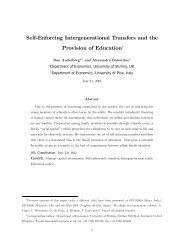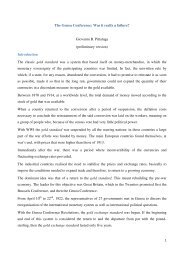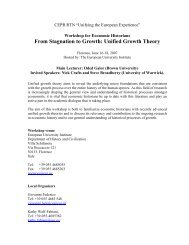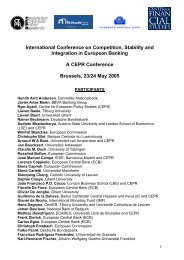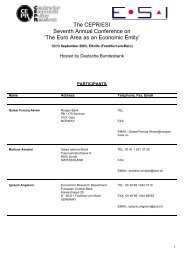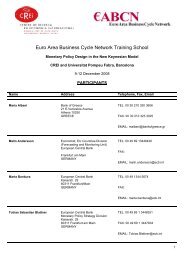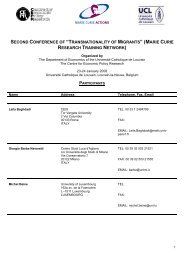MARKET STRUCTURE AND ENTRY: WHERE'S THE BEEF? - CEPR
MARKET STRUCTURE AND ENTRY: WHERE'S THE BEEF? - CEPR
MARKET STRUCTURE AND ENTRY: WHERE'S THE BEEF? - CEPR
Create successful ePaper yourself
Turn your PDF publications into a flip-book with our unique Google optimized e-Paper software.
3.4. Entry and Market Structure<br />
In Table III we give some statistics relating to the number of outlets, and the<br />
number of entries. As can be seen, McD is clearly larger than BK. Our sample includes a<br />
clearly larger proportion of McD than BK outlets: the main explanation for this is are<br />
BK’s smaller size and its relatively larger number of transit outlets (these constitute 25%<br />
of BK’s, but only 7% of McD’s stock). Although BK has grown faster in relative terms<br />
during our sample period, McD has grown faster in absolute terms. Notice also the large<br />
difference in the proportion of franchised outlets.<br />
[TABLE III HERE]<br />
[ FIGURE 1 HERE]<br />
Let us take a first look at the market structure and entry data. In Figure 1 we<br />
detail the proportions in which different market structures are observed, and display the<br />
firms’ entry behavior conditional on market structure. A code (M,B) refers to a market<br />
structure where McD has M, and BK B, outlets at the beginning of the period. Some<br />
market structures (e.g., (0,3)) are never observed in the data, and others appear very<br />
infrequently. We have therefore included as final categories market structures with firm i<br />
having 3 or more outlets, and firm j either 0 outlets (labeled (G,0) and (0,G)), or fewer<br />
outlets than firm i ((G,



